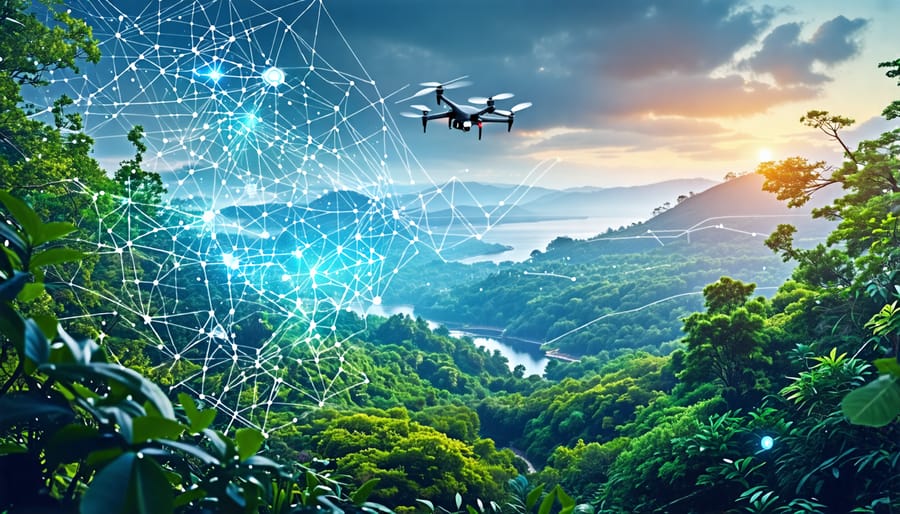Explore the potential of advanced GIS by integrating geospatial data with artificial intelligence to unlock nuanced insights across diverse industries. Harness machine learning algorithms to analyze complex spatial data sets, enabling smarter decision-making in urban planning, environmental conservation, and disaster management. Embrace cloud-based GIS platforms for real-time data sharing and collaboration, enhancing efficiency and facilitating seamless integration with existing systems. Implement 3D mapping and visualization tools to create immersive and interactive experiences, allowing for better interpretation and communication of …
Quantum Computing Meets AI: A New Era of Possibilities and Impacts
Explore the transformative power of combining quantum computing and AI by examining key research, such as Google’s demonstration of quantum supremacy. Understand how this synergy accelerates AI computations, leading to breakthroughs in complex problem-solving. Consider IBM’s quantum AI initiatives, which aim to optimize machine learning algorithms, offering new insights into data processing speeds and accuracy. Reflect on real-world applications like drug discovery and weather prediction, where quantum-enhanced AI is already showing potential. Stay informed about ongoing advancements and challenges, such as error correction and…
How Carbon Sequestration in Agriculture Could Be a Climate Game-Changer
Discover how carbon sequestration transforms agriculture into a powerful tool against climate change. Enhance soil health by practicing cover cropping, which not only captures atmospheric carbon but also enriches soil fertility and reduces erosion. Implement agroforestry to integrate trees within agricultural landscapes, providing a dual benefit of carbon storage and biodiversity enhancement. Optimize soil management with techniques like no-tillage farming and crop rotation to boost carbon retention in soil, leading to sustainable and resilient farming ecosystems. Consider biochar application, a method that locks carbon in the soil for …
How Quantum Physics is Revolutionizing Modern Medicine
Unlock the potential of quantum physics in medicine by exploring these transformative advancements. Harness quantum computing to revolutionize diagnostic imaging, rendering intricate body scans with unprecedented precision and speed. Implement quantum sensors to detect diseases at their earliest stages, potentially saving lives by identifying conditions like cancer through subtle cellular changes. Leverage quantum mechanics to design targeted drug delivery systems that minimize side effects and optimize treatment efficacy. Embrace the future of personalized medicine by using quantum-inspired algorithms, ensuring tailored healthcare plans …
How Carbon Capture Technology is Revolutionizing Our Planet’s Future
Explore the fundamentals of carbon capture technology by understanding its core methods. Capture CO2 emissions directly from industrial sources through chemical absorption using solvents like amines. Implement physical capture methods such as adsorption, which traps CO2 on solid surfaces, providing practical solutions across industries. Enhance natural carbon sinks using bioenergy with carbon capture and storage (BECCS), combining organic growth and energy production processes. Learn how innovative solutions like direct air capture (DAC) are employed to pull CO2 directly from the atmosphere, as explained in “carbon capture revealed&#…
How Sustainable Materials and Technologies Are Transforming Our World
Adopt sustainable materials in your projects by prioritizing those with low carbon footprints and biodegradable properties. Innovate with cutting-edge technologies such as 3D printing using renewable resources to reduce waste and energy consumption. Collaborate with scientists and engineers to integrate eco-friendly solutions like solar panels and green building materials into your designs. Stay informed on the latest advancements and best practices in sustainability by subscribing to journals and participating in forums dedicated to green technology.
The Science Behind Sustainable Materials
…
The Science of Cooking: How Physics and Chemistry Transform our Meals
Explore the Maillard reaction by searing meat at high temperatures to achieve a flavorful, caramelized crust rich in savory complexity. Understand emulsification by slowly whisking oil into vinegar to create smooth, stable vinaigrettes or mayonnaises, harnessing the power of lipid and liquid interaction. Leverage the process of fermentation to transform simple ingredients like cabbage into tangy sauerkraut, utilizing beneficial bacteria to enhance flavors and preserve food. Delve into the effects of pH on food texture by adjusting acidity levels—marinate meats in citrus or vinegar to achieve tenderization through acidic denaturation of …
Why Azimuth Geology Could Revolutionize Earth Science Research
Unravel the mysteries of azimuth geology by mapping subsurface structures accurately with azimuthal data, which guides in mineral exploration and environmental studies. Analyze geological formations using azimuth surveys to assess their orientation and impact on resource extraction and water aquifers. Foster interdisciplinary research by integrating azimuth analysis with geophysics and remote sensing to enhance land stability and natural disaster prediction. Leverage azimuth geometry to optimize the placement of infrastructure, mitigating geological risks in construction and urban planning. Employ cutting-edge technologies to refine …
How AI is Revolutionizing the Battle Against Climate Change
Utilize AI to model climate scenarios by simulating weather patterns and predicting future climate risks with precision. Deploy machine learning algorithms to enhance renewable energy systems, optimizing wind and solar power generation for maximum efficiency. Implement AI in environmental monitoring, allowing for real-time data collection and analysis to track deforestation and carbon emissions. Leverage AI-driven solutions to develop smart grids, facilitating the efficient distribution of electricity and reducing wastage. These innovative applications demonstrate AI’s potential to combat climate change, backed by insights from …
How AI is Revolutionizing Environmental Science: Unseen Pathways to Planetary Health
Unlock AI’s potential in environmental science by integrating machine learning algorithms to analyze vast ecological data for trends and patterns, enabling proactive conservation efforts. Deploy AI-powered aerial drones to monitor biodiversity, surveying expansive areas quickly while identifying species with high precision. Utilize predictive models to anticipate environmental changes and inform policymakers, thus shaping sustainable development strategies. Incorporate AI tools in climate modeling to enhance the accuracy of predicting future climate scenarios, supporting global efforts toward climate resilience. Expert insights …










